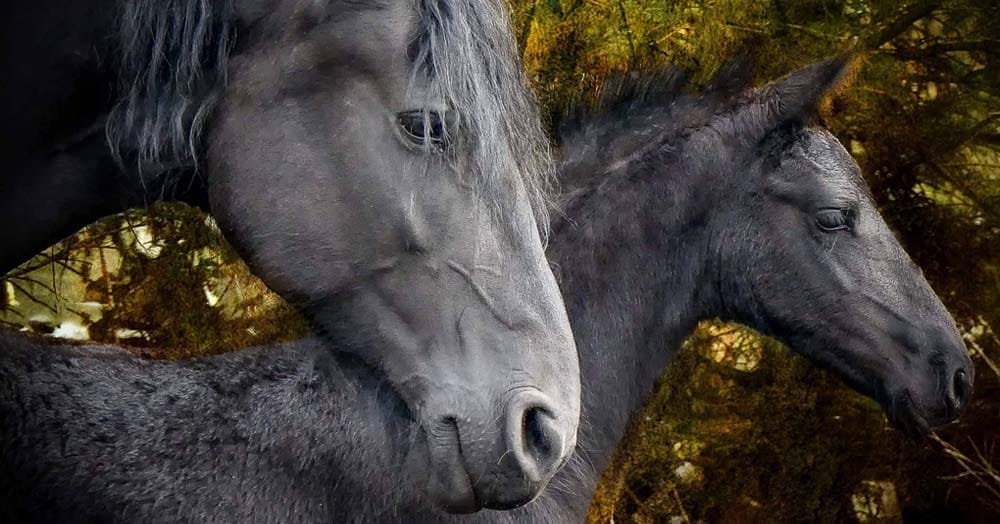French horse breeds has a unique history and a special place in the country’s equestrian heritage
From the resilient Cheval du Vercors de Barraquand to the robust Cheval de Trait Poitevin Mulassier, these breeds offer a glimpse into France’s rich equestrian past. Although they are rare today, their historical significance and distinctive qualities make them valuable and worthy of preservation.
1. Cheval du Vercors de Barraquand

The Cheval du Vercors de Barraquand is a rare breed originating from the Vercors Mountains in southeastern France. This breed is known for its remarkable endurance and adaptability to rugged terrains. It has a compact, sturdy build, designed to handle the steep, rocky landscapes of its native region. Standing between 14 and 15 hands high, the Cheval du Vercors de Barraquand is often used for light draft work and as a pack horse. Despite its historical importance, the breed is rare today due to the decline in traditional mountain farming practices.
2. Cheval de Corse

The Cheval de Corse, or Corsican Horse, is a breed native to the island of Corsica. This horse is known for its hardiness and resilience, traits necessary for surviving the island’s rugged and varied terrain. The Cheval de Corse stands between 13.2 and 14.2 hands high and has a strong, muscular build. Historically used for farming and as a pack animal, this breed is now rare due to the modernization of agriculture and the introduction of other breeds. Despite its rarity, the Cheval de Corse remains a symbol of Corsican heritage and tradition.
3. Castillonnais

The Castillonnais is a French draft breed from the Castillon area in southwestern France. This horse is notable for its strength and endurance, qualities that made it invaluable for farm work and transportation in the past. The Castillonnais has a sturdy, powerful build, standing around 15 to 16 hands high. Today, it is considered a rare breed due to the decline in traditional agricultural practices and the increased use of machinery. Efforts are being made to preserve this historic breed, but it remains a rare and cherished part of French equestrian heritage.
4. Poney Landais

The Poney Landais is a small, rare breed from the Landes region in southwestern France. Known for its agility and versatility, this pony was traditionally used for various tasks, including work on farms and as a mount for children. Standing around 12 to 13 hands high, the Poney Landais has a sturdy build and a calm demeanor. The breed is endangered due to changes in farming practices and the decline in the use of small ponies. However, the Poney Landais is valued for its historical significance and unique qualities.
5. Cheval de Trait Poitevin Mulassier

The Cheval de Trait Poitevin Mulassier, often simply called the Poitevin Mulassier, is a rare draft breed from the Poitou region of western France. This horse is known for its impressive size and strength, used historically for heavy farm work and as a draft animal. The Poitevin Mulassier has a powerful build, standing between 16 and 17 hands high, and is distinguished by its strong legs and sturdy body. The breed has become increasingly rare due to the decline in traditional draft horse use and the shift towards modern farming methods.
| Breed | Origin | Height | Build | Uses | Current Status |
|---|---|---|---|---|---|
| Cheval du Vercors de Barraquand | Vercors Mountains, France | 14-15 hands | Compact, sturdy | Light draft work, pack horse | Rare, due to decline in traditional mountain farming |
| Cheval de Corse | Corsica, France | 13.2-14.2 hands | Strong, muscular | Farming, pack animal | Rare, due to modernization and introduction of other breeds |
| Castillonnais | Castillon, France | 15-16 hands | Powerful, sturdy | Farm work, transportation | Rare, due to decline in traditional agricultural practices |
| Poney Landais | Landes region, France | 12-13 hands | Sturdy, agile | Farm work, children’s mount | Endangered, due to changes in farming practices and decline in use |
| Cheval de Trait Poitevin Mulassier | Poitou, France | 16-17 hands | Large, robust | Heavy draft work | Rare, due to decline in traditional draft horse use |




